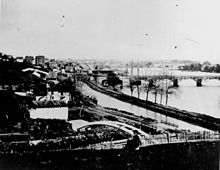19th century[edit]
By the 1820s, the Potomac River had become silted up and was not navigable up to Georgetown. Construction of the Chesapeake & Ohio Canal began in July 1828, to link Georgetown to Harper's Ferry, Virginia (now West Virginia). But the canal was soon in a race with the Baltimore & Ohio Railroad and got to Cumberland eight years after the railroad, a faster mode of transport, and at the cost of $77,041,586. It was never profitable. From its beginning to December 1876, the canal earned $35,659,055 in revenue, while expending $35,746,301.[8]
The Canal nonetheless provided an economic boost for Georgetown. In the 1820s and 1830s, Georgetown was an important shipping center. Tobacco and other goods were transferred between the canal and shipping on the Potomac River. As well, salt was imported from Europe, and sugar and molasses were imported from the West Indies.[8]These shipping industries were later superseded by coal and flour industries, which flourished with the C & O Canal providing cheap power for mills and other industry.[12] In 1862, the Washington and Georgetown Railroad Company began a horsecar line running along M Street in Georgetown and Pennsylvania Avenue in Washington, easing travel between the two cities.
The municipal governments of Georgetown and the City of Washington were formally revoked by Congress effective June 1, 1871, at which point its governmental powers were vested within the District of Columbia.[13] The streets in Georgetown were renamed in 1895 to conform to the street names in use in Washington.[14]
By the late 19th century, flour milling and other industries in Georgetown were declining, in part due to the fact that the canals and other waterways continually silted up.[15]Nathaniel Michler and S.T. Abert led efforts to dredge the channels and remove rocks around the Georgetown harbor, though these were temporary solutions and Congressshowed little interest in the issue.[16] An 1890 flood and expansion of the railroads brought destitution to the C&O Canal, and Georgetown's waterfront became more industrialized, with narrow alleys, warehouses, and apartment dwellings which lacked plumbing or electricity. Shipping trade vanished between the Civil War and World War I.[17] As a result, many older homes were preserved relatively unchanged.


No comments:
Post a Comment